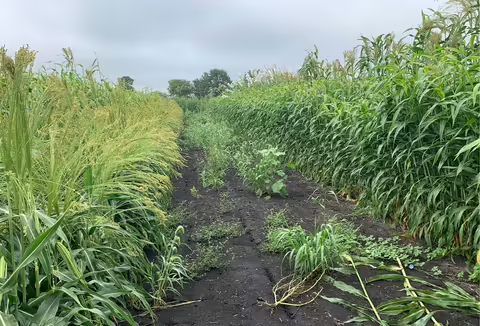When you consider the common field crops in Illinois, it is no doubt that corn (Zea mays) has heavily influenced on agriculture. However, broomcorn (Sorghum bicolor) is a lesser-known member of the grass family (Poaceae) with an agricultural history of its own in our state. Its more closely related to other sorghums than it is to the most popular Poaceae member, Zea mays.
“In Illinois, broomcorn production was established in the early 1800’s and central Illinois became the center for production here in the US,” said Dr. Steven Moose, a Professor of Genetics in the College of ACES at University of Illinois.
What is broomcorn?
As its name implies, the plant is used to make brooms since it produces seed heads with long, fibrous branches that retain their stiff character and attract dust, making them ideal for brooms.
Given broomcorn’s increased drought resistance and relatively high production, even on poorer soils, it became an easy cash crop for new settlers in the Midwest. Over time, its production spread with the expanding prairie frontier to eventually encompass the western states as well.
“It basically migrated as a crop with new settlement,” relates Moose. “It was pretty lucrative for the minimal effort it took to grow it, especially when it fed a local factory, like we had in communities such as Arcola and Paxton.”
Broomcorn Declines
As processing centers developed around this burgeoning new crop, Central Illinois became the center of broomcorn production in the US from about the 1850’s through the 1920’s.
Given its legacy in Illinois, it’s interesting that broomcorn production has waned in the Prairie State today. Many factors were at play in its decline, from cheaply produced plastic broom fibers after World War II to a decreasing labor pool for harvest.
Since broomcorn is grown for its fibrous panicles (seed heads), as opposed to its actual seeds, harvest of this crop is largely performed by hand. In the increasingly mechanized world of agricultural production during the mid-20th century, this hand-harvested crop was simply outpaced by other technology.
However, there is a rich legacy of research on broomcorn in Illinois, founded by former professor Dr. Henry Hadley. Moose began his work with a slightly different perspective, using more recent advances in genetics.
“In past research and breeding, the main goal was to produce a shorter broomcorn with less seeds,” notes Moose. “When I started working with broomcorn in 2014, we did a DNA fingerprinting, or a ‘23andMe’ of broomcorn if you will.”
Understanding DNA has helped Moose describe its long-speculated origins as an agricultural commodity, using historic broomcorn collections the University has maintained over the years.
“We discovered that some kind of mutation has happened to allow the really long fibers on seed heads,” notes Moose. “That mutation has probably happened independently multiple times and has been discovered and bred for by humans multiple times.”
Broomcorn Today
In the past, many of the dwarf broomcorn varieties did not produce a long enough fiber to be useful. Understanding the mutation for long fibers has help current research efforts to create dwarf broomcorn that is shorter and offers the possibility of mechanical harvest, over the traditional, taller broomcorn varieties.
“What we’re trying to do now is revive past work on broomcorn to produce a short, dwarf broomcorn that still has a long enough fiber to viable”, says Moose.
Past researchers did not have the benefit of modern DNA analysis or some of our more recent understanding of grass family genetics and breeding. With the ability to look closer at DNA, Moose has made some interesting discoveries.
“We found that the genes for male sterility are linked to the genes for good broomcorn,” says Moose. “They can be broken, but we didn’t know that in that past and it would have taken a much bigger effort to make this breakthrough.”
Today, hybrid seed corn is produced by crossing a female parent plant, which is male-sterile and incapable of self-pollination, with a male parent plant that contains pollen of desirable genetics. This same approach is used to produce hybrid seed for grain sorghum, or milo, but prior efforts by Dr. Hadley struggled to transfer the sterility trait to broomcorn.
Moose discovered that the genes for male-sterility and longer broomcorn fibers were linked and will require a targeted effort to break that linkage. Past breeding by Dr. Hadley came close to making to making this discovery but were “unlucky” in Moose’s words.
Armed with the knowledge he has now, Moose is hopeful for the future, “If broomcorn could be produced cheaper, it may have applicability in other markets. It also may become more competitive as natural broom fibers.”
“Right now, the limitation is the effort it takes for harvest, but we are working on the right broomcorn for mechanization and I hope that breakthrough can create a viable crop for Illinois markets,” Moose declares.
Research
For more information about Broomcorn Research at University of Illinois, please visit the Stephen Moose Corn Functional Genomics Lab Webpage.
